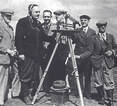Special Constables acting as Observers
In August and September 1924 the first experiments to assess accurate movements of hostile and friendly aircraft were organised by Major General Ashmore. Using the area of land between the Romney Marshes and Tonbridge, Kent; the following trails proved satisfactory. So much so that, in the following year, two observation areas was formed to cover the whole of Kent, Sussex and part of Surrey.
With the co-operation of the Chief Constables concerned, these two areas were sited with observation posts and plotting centres manned by personnel who had been enrolled as special constables. After successful observation exercises undertaken during June 1925, the Observer Corps area was extended during June 1926 to incorporate two further groups covering an area from Hampshire through to Essex and part of Suffolk.
Further tests during 1926, proved consistently successful, and plans were therefore made by Major General Ashmore to expand the Observer Groups into Hertfordshire and Buckinghamshire. During 1929, control of the Corps was transferred to the Air Ministry with the first commandant appointed to the Corps being Air Commodore E A D Masterman CB CMG CBE AFC RAF (Ret’d). On the 15th May 1931, No. 17 Group, with its centre at Watford, was formed and No. 18 Group was enlarged.
- No.1 Observer Corps group was based in Maidstone and consisted of 27 posts
- No.2 Observer Corps group was based in Horsham and consisted of 16 posts
With the co-operation of the Chief Constables concerned, these two areas were sited with observation posts and plotting centres manned by personnel who had been enrolled as special constables. After successful observation exercises undertaken during June 1925, the Observer Corps area was extended during June 1926 to incorporate two further groups covering an area from Hampshire through to Essex and part of Suffolk.
- No.3 Observer Corps group, based at Winchester.
- No.18 Observer Corps group, based at Colchester.
Further tests during 1926, proved consistently successful, and plans were therefore made by Major General Ashmore to expand the Observer Groups into Hertfordshire and Buckinghamshire. During 1929, control of the Corps was transferred to the Air Ministry with the first commandant appointed to the Corps being Air Commodore E A D Masterman CB CMG CBE AFC RAF (Ret’d). On the 15th May 1931, No. 17 Group, with its centre at Watford, was formed and No. 18 Group was enlarged.
This document, the rules for the Observer Corps of Special Constables, is in our archive
Your browser does not support viewing this document. Click here to download the document.
(If the document is not visible in your browser, click here to view it)
On 24 August 1939 Chief Constables issued mobilisation notices to all members of the Observer Corps. At this time the administration, recruitment and payment for voluntary members of the Corps was transferred from the Police Force directly to the Air Ministry. As a result the observers:-
Text source: ROCA Heritage website www.roc-heritage.co.uk
- Relinquished their Special Constable status which formed the initial basis of being a member of the Corps since initial setup.
- Became entitled to a remuneration of 1/3d. per hour, with a maximum of £3 a week and increased to £3 5/- by the award of a 5/- a week War Bonus from 1st July 1940.
- Were given the opportunity for applying for employment on a full time basis (48-hour week) or accepting part time employment.
Text source: ROCA Heritage website www.roc-heritage.co.uk
